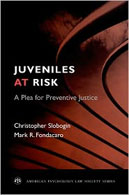Juveniles at Risk: A Plea for Preventive Justice

Authors: Christopher Slobogin and Mark R. Fondacaro
Publisher: New York: Oxford University Press, 2011. 224p.
Reviewer: Laura Cohen | March 2012
Steven had a smile as wide as the western sky. Even if one met him, as I did, in the grim environs of the juvenile court, that smile lit up the room. Yet Steven already had endured a lifetime’s worth of despair when, at the age of 16, he was referred to my law school clinic. Incarcerated father, overwhelmed mother, crime-addled neighborhood – – Steven was the tragedy of incarcerated youth in miniature. He joined a gang at 12, racked up a series of increasingly serious delinquency charges, and, finally, was sentenced to a term in New Jersey’s juvenile prison system. After a year in a secure facility, he came home, determined to graduate from high school and change his life. Three weeks later, while still on parole, Steven was shot and killed by police during an attempted car-jacking. He was 18 years old.
Still reeling from Steven’s death, I read Christopher Slobogin and Mark R. Fondacaro’s Juveniles at Risk: A Plea for Preventive Justice and wondered: could the juvenile justice system it champions, based on individualized crime prevention rather than rehabilitation or retribution, have re-shaped the sad arc of his life? I think not, but the book offers much to mull over.
According to Slobogin and Fondacaro, the existing juvenile justice apparatus has proven ineffective and, at times, harmful. They propose scrapping the current system in favor of an “individual prevention” approach, which would focus not on treatment or punishment for past wrongs but, instead, reduction of future recidivism. The book lays out a “risk management” scheme, in which courts could mandate long-term intervention and, if necessary, confinement, even for minor offenses. Anticipating net-widening objections, they offer up a quid pro quo: outright prohibition of waiver to the adult system.
The argument rests on several premises. First, extraordinary recent advances in our understanding of adolescent and brain development compel a re-thinking of prevalent juvenile justice philosophies. The demise of the purely rehabilitative juvenile court is old news, and, as juvenile crime rates have tumbled since 1994, many commentators have rejected the wave of retributive legislation inspired by John Dilulio’s misguided and, ultimately, disavowed “juvenile super-predator” theory. More of the moment is the authors’ dismissal of Laurence Steinberg, Elizabeth Scott and Franklin Zimring’s highly influential “diminished retribution” approach, which the Supreme Court embraced in Roper v. Simmons (2005)(outlawing the juvenile death penalty) and Graham v. Florida (2010)(outlawing sentences of life without parole for youth convicted of non-homicides).
According to Steinberg and Scott, the normative developmental factors that govern adolescent judgment and decision-making (i.e., impulsivity, vulnerability to peer influence, risk-taking, and differential temporal perspective) render youth “less guilty by reason of adolescence” and, so, deserving of more lenient punishment than adults convicted of similar offenses. Because cognitive development research has established that children older than ten generally are able to formulate mens rea, however, Slobogin and Fondacaro reject this notion of diminished culpability. As they see it, the same developmental factors that Steinberg et al point to as undermining youths’ blameworthiness also “tend to produce offenders for whom the deterrent force of the criminal law is likely to be, literally, an afterthought.” (46) Adolescents thus are “relatively undeterrable,” (44) or impervious to the threat of punishment, and a juvenile justice system predicated on that threat does not produce the desired preventive effect.
The authors further posit that advances in the accuracy of risk assessment evaluations legitimize a system based on individualized risk management, with certain caveats. Acknowledging the imprecision of many risk evaluations, they endorse the use of statistically validated, actuarial-based assessment instruments in conjunction with clinical interviews. This recommendation, rooted in the work of the MacArthur Research Network on Risk Assessment, is consistent with recent systemic reform efforts in both the juvenile and the adult contexts; the Annie E. Casey Foundation’s Juvenile Detention Alternatives Initiative, for example, has made validated risk assessment processes a centerpiece of its national detention reform effort, and New York recently amended its adult parole law to compel Parole Board members to base release decisions on “risks and needs principles.” See N.Y. Exec. Law §259(c)(4).
Finally, research meta-analyses establish convincingly that incarceration is less effective than many community-based responses to juvenile crime and, in fact, probably increases the likelihood of recidivism. The book thus looks to several evidence-based, programs, including the increasingly-utilized Multi-Systemic Therapy and Functional Family Therapy, as potential alternatives to confinement. “Overall, a fair appraisal of ‘state of the art’ intervention strategies suggests that ecologically oriented, cognitive-behavioral interventions aimed at the multiple life contexts in which juveniles exist . . . can be both clinically and cost-effective . . . and lend themselves nicely to a risk management model.” (35)
What would an “individualized prevention” system look like, and how would it differ from current practice? First, the reach of the juvenile court would widen significantly. Because current psychological and brain development research has pushed the dividing line between adolescence and adulthood up from age 18 to the mid-20’s, the book proposes raising the juvenile court’s “age jurisdiction” accordingly. And, while delinquency complaints still would charge commission of specific jurisdictional acts, the list of those acts would expand to include minor offenses that currently do not lead to prosecution but are linked in the literature to a high risk for future criminal behavior. Additionally, the authors would permit prosecution for negligent acts, on the theory that, if the goal of intervention is risk management, youths who engage in negligent conduct may pose as great a risk of recidivism as those who behave intentionally or recklessly. (67)
The book would mandate a risk assessment evaluation after any juvenile adjudication. If, based on the assessment, the court finds intervention to be warranted, an inter-disciplinary risk management team would develop and implement a risk-management plan. The team would periodically re-evaluate the young person and recommend changes to the plan and, when appropriate, the termination of court jurisdiction. Although most youth would be compelled to participate in community-based preventive programs, those presenting the highest risk of recidivism could be confined for indeterminate terms.
Counterbalancing the expansion of juvenile court jurisdiction is the outright abolition of transfer to the adult system. This is a welcome proposal, as the criminogenic effects of transfer and the abuses suffered by youth incarcerated in adult facilities, are well-documented. As the authors note, furthermore, despite the dictates of Kent v. U.S. (1966), most states now permit transfer based solely on offense severity, with no consideration given to amenability to treatment. Modern transfer laws thus serve purely retributive, rather than preventive, ends and have no place in a risk-management system.
So far, so good. Preservation of the juvenile court, elimination of transfer, increased use of effective programs – – these are on any “top 10” list for juvenile justice reform, and the book’s embrace of them helps overcome obvious proportionality objections to a system that permits indeterminate incarceration for minor offenses. What gives pause, however, is the suggestion that, in such a system, core due process protections – – including the right to counsel, the privilege against self-incrimination, and the right of cross-examination – – are unnecessary or even harmful.
The argument goes as follows: procedural justice studies suggest that the adversarial process does not necessarily promote the public’s perception of system fairness or enhance the accuracy of fact-finding; in contrast, mediation and other alternative dispute resolution approaches have been found to advance these goals in the adult criminal context. These findings, together with the success of modern treatment courts, suggest that an investigative approach would better serve the ends of a prevention-based delinquency system. In an investigative system, however, certain procedural protections would be eliminated; for example, young people would not be permitted to “hide behind their lawyers” (119) but, instead, could be compelled to testify in furtherance of treatment and restorative justice goals.
This approach is constitutionally sound, the book asserts, pursuant to Kansas v. Hendricks (1997), which upheld post-incarceration civil commitments of sex offenders on the ground that these serve preventive, not punitive, goals. Like Hendricks, which permits confinement of those who are demonstrably “dangerous beyond their control,” an “individual prevention” system would only permit incarceration of youth who are “relatively undeterrable, and, so, categorized as civil, rather than criminal, free from the dictates of the Fifth and Sixth Amendments. For additional support, the authors point to the Supreme Court’s framing of juvenile rights in due process, rather than direct incorporation, terms, which, in their view, rendered the question of what process is due somewhat elastic.
This reliance on Hendricks ignores fundamental distinctions between civil commitments and delinquency adjudications. Adults facing such commitments are accorded the full panoply of due process protections during the proceedings that lead to their underlying convictions. Adelinquency adjudication, however, gives rise not only to the threat of incarceration but also to substantial collateral consequences, including sex offender registry and notification requirements, possible deportation, inclusion in DNA and fingerprint data bases, school expulsion or suspension, loss of driving privileges, and exclusion from public housing. The book fails to propose elimination of these penalties, which render delinquency proceedings more akin to original criminal complaints than subsequent civil commitments and compel provision of similar procedural protections.
In a particularly provocative paragraph, the authors question the foundation of the modern juvenile court, the 1967 Gault decision. In 1964, 15-year-old Gerald Gault was accused of making a lewd phone call to his neighbor. Gerald was arrested and taken, without notice to his parents, to the local detention center. Once there, he was interrogated by Charles Flagg, the town’s juvenile prosecutor and probation officer. The resultant delinquency petition contained neither a specific allegation as to what Gerald was accused of saying to the neighbor nor a specific criminal charge; in fact, at a habeas hearing held two months later, the judge, Robert McGhee, could not articulate the precise basis for his determination of delinquency. At “trial,” Gerald did not have a lawyer and the neighbor was not required to come to court, despite a specific request by Gerald’s mother. Instead, Flagg was the only witness and was not subject to cross-examination. No transcript was made of the proceeding and, although Judge McGhee asked Gerald questions about the incident, at the habeas hearing those present remembered markedly different versions of his “testimony.” The judge ultimately adjudicated Gerald delinquent and, in the name of “rehabilitation,” committed him to the state training school until his 21st birthday. An adult convicted of a similar charge would have faced a maximum sentence of 30 days in jail. In re Gault (1967).
Declaring that the “condition of being a boy does not justify a kangaroo court,” id, 367 U.S. 1, 28 (1967), the Gault Court held that children charged with delinquency enjoyspecific due process protections. Yet, according to Slobogin and Fondacaro,
Gerald Gault’s “trial” may not have been the egregious violation of procedural rights it is often said to be. Neither the failure to give the Miranda warnings nor the direct questioning by the judge necessarily infringed due process. While Gerald Gault should have been told his charges and been allowed to see the “referral report” against him, the relevant information was presumably communicated to him by the judge. The absence of the complaining neighbor may have been irrelevant if Gerald had fully confessed to the “crime.” Even the absence of a lawyer may not have been prejudicial, given the simplicity of the charge and the presence of his parents. (120)
This attempt to reconcile the book’s thesis with constitutional demands in fact accentuates the essentiality of procedural protections. Judge McGhee’s inability to recall basic details about the case just a few months later makes it unlikely that he “communicated” necessary information to Gerald. Gerald’s “confession” was ambiguous at best, yet the judge denied Marjorie Gault’s intuitive request to confront and cross-examine the complainant. The scant record that exists, furthermore, establishes that, despite the “simplicity of the charge,” Gerald understood nothing of the proceedings. Many years later, he still spoke movingly of his inability to grasp what was happening until he realized that his six-year sentence was longer than he could count on the fingers of one hand.
Particularly troubling is the suggestion that juvenile defense attorneys may be unnecessary or even harmful in a preventive regime. National juvenile justice standards have long recognized that, far from undermining preventive goals, skilled juvenile defenders advance procedural justice and the pursuit of truth in a number of ways. The high rate of juvenile false confessions and false guilty pleas renders vigorous defense representation essential to prevent wrongful convictions. The frequent incidence of special education and mental health needs among young people charged with delinquency, as well as their developmental immaturity, further require juvenile defenders to interpret the system for their clients to ensure informed, competent decision-making. Counsel for youth also play a crucial role in challenging systemic biases, conditions of confinement, and other grave concerns. In short, unless and until delinquency prosecutions no longer pose the twin threats of involuntary commitment and devastating collateral consequences, juvenile defenders remain essential checks on a system that has never been able to police itself.
Rather than recommending outright abolition of the right to counsel or other components of post-Gault due process, the book stakes out a murky middle ground, calling for an “experimental” system that engages in ongoing “feedback, evaluation, and reform.” (113) In other words, some procedural protections may be necessary to promote the goals of perceived fairness and accuracy, but courts should be free to change things up depending on how they are working. As attractive as this suggestion is, the juvenile justice system is remarkably unresponsive to its own failings; after all, the shortcomings of the early 20th century Children’s Court were evident by the 1930’s, yet it was not until 1966 that the Supreme Court began to tackle the problem in Kent. As the recent “cash for kids” scandal in Luzerne County, Pennsylvania, made clear, the loss of procedural protections can lead to catastrophic consequences for youth and, if implementation of the book’s proposals unwittingly brought about a return of the “kangaroo court,” it could take years to undo the damage – – particularly if children did not have lawyers challenge abuses. In addition, the proposed trade-off between process and prevention assumes adequate funding and political support for alternatives to incarceration. Historically, however, these are hard-fought battles, and one bad budget cycle could lead to decimation of funds for preventive programs without an immediate restoration of procedural rights.
The book is well-written, coherent, and, in its rejection of transfer, seductive. Ultimately, I was not convinced that the abandonment of due process is a necessary precursor to implementation of a risk-management system. Perhaps, though, if Steven’s needs had been addressed from a preventive, rather than punitive, perspective, he might today be preparing for his longed-for high school graduation. Perhaps.
References:
Elizabeth Becker, “As Ex-Theorist on Young ‘Superpredators,’ Bush Aide Has Regrets,” N.Y. Times, 02/09/2001, available at http://www.nytimes.com/2001/02/09/us/as-ex-theorist-on-young-superpredators-bush-aide-has-regrets.html?pagewanted=all&src=pm.
Jeffrey A. Fagan, “The Comparative Advantages of Juvenile Versus Criminal Court Sanctions on Recidivism Among Adolescent Felony Offenders,” 18 Law & Policy 77 (2000).
National Council of Juvenile and Family Court Judges, Juvenile Delinquency Guidelines: Improving Court Practice in Juvenile Delinquency Cases (2005)
National Juvenile Defender Center and National Legal Aid and Defender Association, Ten Core Priniciples for Juvenile Indigent Defense Delivery Systems (2d Ed., 2008)
Laurence Steinberg and Elizabeth S. Scott, “Less Guilty by Reason of Adolescence: Developmental Immaturity, Diminished Responsibility, and the Juvenile Death Penalty,” American Psychologist 1009 (December 2003)
Franklin Zimring, “Penal Proportionality for the Young Offender: Notes on Immaturity, Capacity, and Diminished Responsibility,” Youth on Trial (Thomas Grisso and Robert G. Schwartz, Eds.)(University of Chicago Press: 2000)
In re Gault, 387 U.S. 1 (1967)
Graham v. Florida, 560 U.S. ___ (2010)
Kansas v. Hendricks, 521 U.S. 346 (1997)
Kent v. U.S., 383 U.S. 541 (1966)
Roper v. Simmons, 543 U. S. 551 (2005)
Laura Cohen is a Clinical Professor of Law at Rutgers School of Law-Newark, the Co-Director of the Northeast Juvenile Defender Center, and a member of the national advisory board of the National Juvenile Defender Center.


